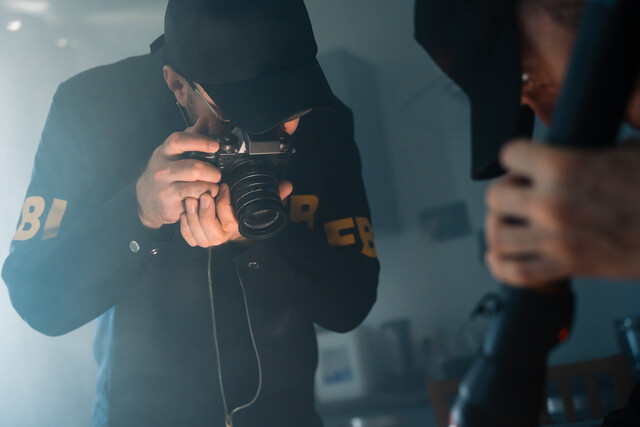Introduction
Like many jobs and tasks, planning is one of the first steps toward developing a thorough interpretation or action steps needed to reach any goal. In the process of crime scene investigation, this approach is not only common sense, but also vital. To properly analyze and interpret any crime scene, certain basic steps must be followed in order to create a sense of beginning and a sensible conclusion to the examination. The steps employed to adequately assess any crime scene are, quite basically, to interview, examine, photograph, sketch and process a crime scene.
Processing a crime scene requires great attention to detail and nuance. In order to preserve evidence, proper steps must be taken in chronological order. What would happen if the victim were taken to the coroner's office before photographs were taken? Or what might occur if the crime scene investigator waited several days to sketch what he recalled of a crime scene?
It is obvious that an orderly process must be taken throughout the crime scene, and this can be done in a number of ways. Before anything is touched or collected as evidence, it must be found and clearly marked. How do you go about finding and marking that evidence? There are several methods used by law enforcement agencies throughout the world that follow six basic crime scene search patterns.
- Strip method
- Wheel method
- Spiral method
- Zone method
- Grid method
- Line method
The use of any or a number of these search methods will be determined by the location and size of the particular crime scene; the one that is chosen is less important than the fact that the search is carried out with due diligence and attention to detail.
The strip method requires that crime scene personnel walk a path from one end of the crime scene, over to the other side of the room or area, and then return in the direction from which he or she first started. Every lap brings the investigator closer to the center of the room or space being searched. The appearance is similar to someone swimming laps in a pool.
The wheel method employs the use of several crime scene personnel or searchers. Starting in the middle of an imaginary circle, each investigator moves in a direction straight out from the center, or "hub" of the wheel, much like the spokes of a bicycle wheel. However, it is possible to destroy unseen evidence in the "hub" area if extreme care is not taken to watch where investigators are stepping as they gather in the center of the search area.
The spiral method has the investigator(s) examining the area for evidence in an ever-widening circle, from the position of the core crime scene or on the perimeter and then moves in an outward direction.
The zone method breaks the crime scene area into squares. For example, a living room can be divided into four equal sections and examined by an individual investigator. In many cases, those squares are further divided into additional, smaller squares to facilitate evidence location.
The grid method is best used in large crime scenes such as fields or woods. Several searchers, or a line of them, move alongside each other from one end of the area to be searched to the other. Imagine a string of a dozen officers walking at arm's length down a football field. At the opposite end, they turn and perform the same search, though moving in the opposite direction in consecutive laps. Then, they search again, moving across the field at a 45-degree angle to where they first started, until the entire area has been covered.
The line method is best used outdoors as well, and is similar to the grid search with the exception that searchers generally only move in one direction, from one side of the search area to the other. Because of trees, shrubs, rocks or other objects that may make a grid search unfeasible, the line method search is the next best method to use.
As always, remember that the search for any type of evidence starts and ends with the protection and preservation of the crime scene. The greatest amount of evidence may be found in the immediate vicinity of the victim, so when deciding on which type of a search to use, care should be taken to select one what will not disturb or otherwise contaminate potential evidence. Remember, anything and everything may eventually become evidence and the crime scene investigator must never take anything for granted.
Certainly, interviewing witnesses upon arrival at the crime scene is one of the first steps that should be taken in order to gain the freshest recollections of what has occurred. Questioning witnesses immediately always offers the best chance for law enforcement personnel to get the most information from bystanders or those involved in some way with the crime scene. If witnesses are not available when the crime scene investigator arrives, they should seek out the first officer or detective on the scene and attempt to ascertain what is believed to have occurred: a murder, a suicide, or an accident.
Following that, the crime scene must be examined and perimeters determined, if they have not already. The first examination of the crime scene should be visual, with the crime scene investigator using his or her best judgment to try to spot potential evidence or areas where evidence may be, as well as to buttress the beliefs of the type of crime scene it is. For example, the first officer to arrive at a crime scene may believe it is the scene of a suicide, while the experienced eye of a crime scene investigator may determine rather quickly, due to various blood or other physical evidence, that a murder is actually what has occurred.
Before anything is touched, it must be photographed. That goes for the victim and anything else found in the crime scene. That means something as small as a hair or as large as a sofa. It is vital that the actual crime scene be photographed to "freeze" everything in place before the body is moved or evidence collected. Never, under any circumstances, should police officers or other law enforcement personnel, or crime scene investigators themselves, draw a chalk line around a victim before he or she or they have been photographed. Doing so disturbs the crime scene and may cause any photographs or evidence found near the victim to become inadmissible in a court of law.
Crime scene photographs usually are taken of the core crime scene and then encompassing surrounding areas. For example, if a victim was found in the bathroom of his house, a majority of the crime scene photos would be taken in the bathroom, but then photographs of the rest of the house, and perhaps even the outside, would be taken in order to offer some sort of continuity to the entire overall location.
Even though extensive photographs are taken at a crime scene, police, detectives and crime scene investigators also draw crime scene sketches. Such drawings encompass the totality of the crime scene, as well as the position of the victim in relation to the rest of the crime scene. Locations where evidence has been found, as well as drops or smears of blood are also marked on the diagram.
Sketches enable investigators to easily recall a crime scene, and places the entire crime scene into perspective, and along with photographs, can provide a much clearer idea of the overall investigation, as well as to pinpoint individual pieces of evidence through a house, for example. A bird's eye view sketch of a crime scene enables the investigator to take in the entire scene in one glance, something that is often not possible with a photograph.
A crime scene sketch may be simple, and use stick-men drawings to designate locations and measurements, or it can be more detailed. If the person charged with documenting the crime scene is somewhat gifted in drawing or sketching, amazingly complete and detailed sketches can be made of a crime scene, which helps not only investigating officers, but lawyers and other courtroom personnel later down the line.
-
After the entire scene has been photographed, the gathering of evidence can begin. The crime scene investigator will typically begin his or her search for evidence at the point of entry of the perpetrator, if it can be found. Broken windows, torn screens and broken door locks are obvious points of entry and egress.
During the course of processing the scene for evidence, it is important for crime scene personnel to take extensive notes on what occurs at the scene for later reference. Such notes should detail every step taken during the process. What should the crime scene investigator take notes on? Some common items found in the notes of experienced crime scene investigators include the following:
- Where blood was, or was not found.
- Anything unexpected found at the crime scene.
- Initial impressions of the crime scene.
It stands to reason that the most sensitive evidence must be collected first. That means, for example, hairs and fibers before clothes or the murder weapon. In outdoor condition, anything that can blow away or be destroyed by rain or sun should be collected before larger objects are considered.
In addition, an experienced crime scene investigator will note directions with measurements. For example, if a blood pool was found near the victim, it should be noted, "on the bedroom floor, 5 inches west of the east wall" or "2 feet north of the south wall" or some such, in order to provide accurate and specific locations of all pertinent evidence.
To keep accurate records of the documentation process and examination of a crime scene, it is also important to record which person has performed a specific task. For example, the names of all personnel involved in the processing of the crime scene should be noted, as well as who was in charge of taking photographs or collecting fingerprints or directed to sketch the scene.
The exact location of the body should be noted, along with as detailed a description of the crime scene as possible. Locations of any evidence found at the crime scene needs to be documented and the names of the person who collected it should also be noted.
ConclusionThe processing of a crime scene can involve two or three people, or dozens, depending, once again, on the circumstances and the location. In order to prevent charges of improper handling or documentation at a later point in time or during the course of a trial, all evidence collection must be carefully noted and documented. Remember, once the crime scene is released, once the body has been removed, it can never be perfectly reconstructed again. That is why it is so important to combine every aspect of the investigation, from photographs, measurements, drawings, diagrams, and notes, to provide as concise and as thorough of a case file as humanly possible.

























